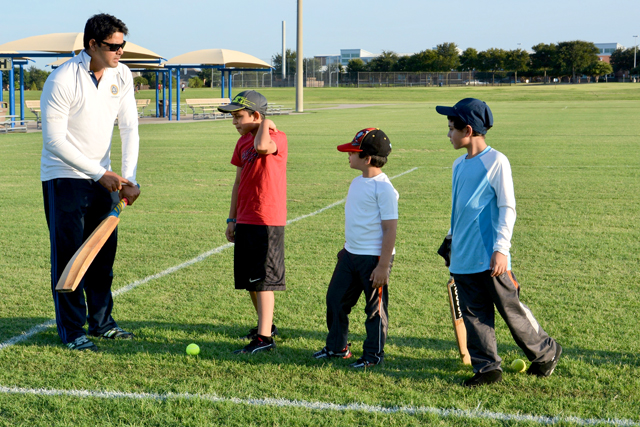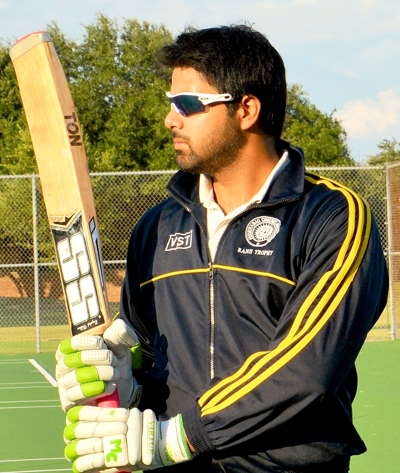
Fahad Shahnawaz working with youth cricketers to help improve their basics of cricket from the grassroots level up.
Though we have not had occasion to meet with Fahad Shahnawaz recently, we are excited to have the opportunity to interview him and record some of his thoughts about the progression of first-class cricket in the United States.
First, a little about Fahad’s play in the United States. He has in-depth observation on cricket in America because he has played cricket in various regional tournaments across the nation, and with numerous prestigious and exclusive cricket leagues. Initially he was invited by US cricket officials in 2006-2008 to train and work with some of the best US cricketers. He worked and played in the famed Midwest Cricket League, in Dayton, Ohio. Since then, he has been inspiring cricket development at the grassroots level, working with various cricket leagues in the United States, to expand and grow the popularity of cricket in the United States.
Here is a quick snap-shot of Fahad Shahnawaz’ first-class cricketing journey:
Major teams represented during his first-class cricketing career:
• Hyderabad Under-22s
• Hyderabad Ranji team
• South Zone team in Vizzy Trophy
• Invited in 2013 to NY Cricket Region’s training program, in preparation for the US National Tournament
• Currently playing for Irving Cricket Club in the North Texas Cricket Association
Unfortunately, he has not been able to play for Team USA, despite several invitations to do so. Tragically, the International Cricket Council, the world governing body for all of cricket globally, has four-year restriction on former international cricketers representing another country in international matches. If a foreign cricketer wants to play for a foreign country, he needs to stay resident in that country continuously for four years, before he can play for that country. Unfortunately, when Fahad was eligible to play international cricket for the United States in 2013, he was sidelined due to a major knee injury sustained in a US national tournament.
Fahad Shahnawaz
Fahad has undergone intensive rehabilitation and experts believe he is now ready to return to competitive cricket, and represent the United States at the international level. There is no doubt that Fahad will be an asset to United States cricket, as he has competed successfully at the international representing the nation of India, and continued his meteoric rise in the US. His experience will assist Team USA in making its mark on the international cricketing map.
Fahad has trained as a professional cricketer, and under the guidance of world-renowned coaches such as Arshad Ayub, M. R. Baig and Dennis Lillee.
• Fahad has been a product of Arshad Ayub’s Cricket Academy in Hyderabad, India. Arshad Ayub is a former Indian national cricketer, who has embraced cricket coaching as a passion, to improve cricket from its grassroots level. Arshad Ayub is a well-known cricket figure in India. Fahad, trained by Arshad Ayub, was a major team player for Ayub’s cricket teams over the years. Moreover, Fahad has captained the Arshad Ayub Cricket Academy on a tour in England in 2004.
• Mohammed Rehmat Baig has coached Fahad during his international playing stint for India. Mr. Baig played first-class cricket for Hyderabad and is very well-known for his cricket coaching techniques. He has coached more than 500 Ranji Trophy cricketers and international players. Players like M. L. Jaisimha, Mohd Azharuddin, VVS Laxman and Fahad Shahnawaz. Fahad said, “It was a privilege to be coached by Mohammed Rehmat Baig, and I would never have reached the international competition levels in India, without his guidance.”
• Dennis Keith Lillee, is a former Australian cricketer rated as the “outstanding fast bowler of his generation”. He was also associated with MRF Pace Foundation in India, coaching fast bowlers until recently. Fahad has been a part of MRF Pace Foundation under Dennis Lillee at Chennai, India.
Fahad has also learned cricket by playing with the international legends of his time. He says that he is fortunate to have played alongside some very famous cricketers, and was the recipient of tips on developing his cricketing skills. Some examples of those international cricketers are:
Fahad Shahnawaz (extreme left) listens to coach Mark Demos from Zimbabwe address Dallas Cricket League players set to participate in an inter-city tournament in Houston, TX.
Mohammad Azharuddin – a former Indian national cricket captain
VVS Laxman – a former Indian national cricketer who was awarded the Padma Shri award, India’s fourth highest civilian award from the Government of India
Venkatapathy Raju – a former Indian national cricketer
Zamin Amin – a former USA national cricket captain, and a left-arm orthodox spin bowler, who played for the USA national team from 1990 to 2004
Amjad Khan – a well-known US national cricketer who made his first-class debut for Jammu and Kashmir in the 1988/89 Ranji Trophy season against Delhi, and was selected to play for the United States in 2000
Jermaine Jay Charles Lawson – a professional cricketer and fast bowler from Jamaica, West Indies, who has played at the Test and One Day International levels, for the West Indies
Cameron Eustace Cuffy – a former powerhouse West Indies Test fast bowler who has been largely responsible for advancing cricket in the Americas.
Mervyn Dillon – a former West Indies Test cricketer, who has played 38 Test matches and taken 131 first-class wickets. He has also played 108 One Day International matches between 1997 and 2004
Fahad’s Vision for the Development of Cricket in the United States
Fahad’s vision for the development of cricket in the US involves the transformation of traditional weekend cricket into professional leagues. He believes that cricket in America is a weekend sport, where people play for fun and has scarcely reached the level of professionalism that is required to make US men’s cricket more competitive in international play against the cricketing giants, such as India, Australia, and England.
As sponsorship is sparse, many cricketers approach the game as a recreational activity. Building a career in cricket needs to garner compensation at the levels which our counterparts are earning in other countries, and this will in turn attract the world’s best talent to come and play cricket in the United States, and against fully-developed American teams. If he had not received an honorarium when invited to play cricket in the United States in 2006, he would never have considered coming to the United States to play cricket.
However, Fahad’s love of America and his passion to see the sport grow in this country, is what drives him to succeed in his vision of America competing successfully on the world stage.
Improvised Shots Should Not Be Played at the Lower Levels of Cricket
As Fahad traveled and played cricket in many States across the nation, he has watched cricketers playing improvised shots at the lower level of sport. He said, “Cricketers in the United States need to develop from the grassroots level, and adhere to the basics of the sport, while avoiding shot improvisation.”
Proper Cricket Coaching and Discipline are Very Important
Fahad has come from an environment where playing an improvised shot at the basic levels would be considered an offense. Discipline is a critical part of the development of cricket at the grassroots level.
Fahad recalls being suspended for a week from the cricket coaching sessions for playing improvised cricket shots. Cricket has sixteen basic batting shots from front foot defense to pull and a hook shots. As players are exposed to bowlers at a higher level of the sport and according to the position of the fielders, the situation may demand a batsmen play an unorthodox shot or improvised shot, so that they keep ticking the scoreboard. Until he was able to master the basic shots, he wasn’t allowed to play any unorthodox shots. Those were the disciplinary standards addressed while learning cricket.
Elite cricket coaching starts with the basics, followed by improvisations, then comes the coaching for the first-class level, then the international level. Contemporaneously, the fitness, reflection, and decision-making process has to be developed. For example, the batsman has to make a decision of playing a shot in a fraction of a second, in that fraction of a second, the batsman has to exercise proper shot selection. The decision-making process has to be prefect, so that the batsman doesn’t get out playing a wrong shot. To play the selected shot he needs to have a fast reflection and proper technique.
We Need to Raise the Level of Enthusiasm to Attract Sponsorship
If we have players who can compete at the international levels, and bring laurels to our country, we can generate enthusiasm for more people to play the sport. Fahad wants to be a part of that process, and he strongly believes, “If there are more people involved, we would have more sponsors, hence more money for grassroots development, and therefore, advance cricket to the professional level much faster.
To make this happen Fahad believes, “We need to have cricketers who are not only determined, dedicated and passionate, but must also be trained in the ways of international competition, and master all the skill sets associated with first-class cricket. Moreover, the cricketer has to be knowledgeable and skillful, so that he may help the less experienced cricketer who can correct the mistakes and implement corrective action to validate it.” This is something that international first-class cricketers are doing for the United States, and we are grateful to have Fahad here in the United States to help advance the level of play in our country, and vault US cricket to the forefront of international competition.
